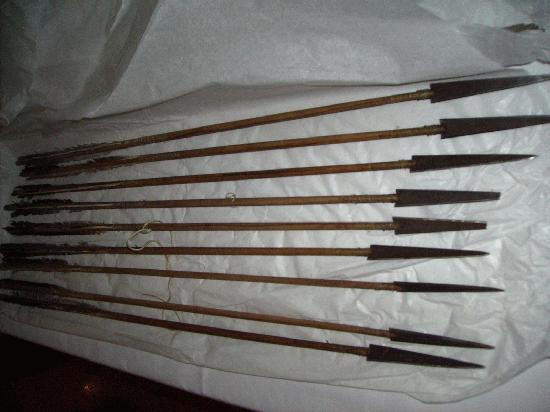Home › Forums › Friends of FOC › MA and FOC in Sioux buffalo arrows
-
AuthorPosts
-
-
My friend Alex Bugnon sent me this pic and wrote “Mid 19th century Lakota arrows for Buffalo hunting. Photo coutesy of my Facebook friend Jay Red Hawk.” Alex was impressed by the MA, Mechanical Advantage, namely the extreme length to width ratio. The heads clearly are metal, and a common source at that time, esp. in areas where wagon trains went through, was discarded iron wheel rims. It was soft but it was thick and heavy. Given the rust on these, that’s my best guess. Alex is trying to get more info from his friend. This sure would beat shooting bison with “bird” points!

-
Wonder what the arrows weigh?
Sure would like to measure and balance those puppies.
Troy
-
They appear very long also. And Plains tribes tended to use fairly short bows for horse-mounted bison hunting, suggesting a lot of arrow projecting in front of the bow for even more FOC. Wonder if they knew about single-bevel? 😆
-
I don’t see any tanto tip on those puppies 😀
-
That could be why several of the tips are broken off. 😛
-
David Petersen wrote: This sure would beat shooting bison with “bird” points!
No kidding. A little hard to tell in the pic, but the fletching seems long, but also quite low profile?
Tell Alex to swing by more often. I always enjoy his contributions.
-
David Petersen wrote: … in areas where wagon trains went through, was discarded iron wheel rims. It was soft but it was thick and heavy. Given the rust on these, that’s my best guess…
Hmmm… there was an old barn on my folks farm when I was a kid that had a covered wagon in it. There were also several extra wheels and rims laying around. I don’t know what the story of the wagon was, and it is now returned to the dust of ages.
But, as a kid, those rims were a magnet to me. I made many things from them, including some throwing knifes. My experience with the steel is that it was super hard and springy. It took an edge well, and wouldn’t break after my throwing knifes were cast into the trunks of trees for untold number of times (as other metals did). Which makes sense. you wouldn’t want it soft, or it would get worn off by the rock in no time.
But the metal would have been unworkable without good tools. Which makes me wonder how they worked it.
-
I’d put my money on barrel hoops. I’d think they were pretty common as well, and would have been a hell of a lot easier to work. They’re only about 1/8″ thick, and would have been realativly easy to work down and haft into a shaft.
ch
-
Clay Hayes wrote: I’d put my money on barrel hoops. I’d think they were pretty common as well, and would have been a hell of a lot easier to work. They’re only about 1/8″ thick, and would have been realativly easy to work down and haft into a shaft.
ch
I had a friend, (now deceased) that had many Indian artifacts that he found. looking for Indian relics was his passion. He also told me the Idians used the steel from wagon wheel rims to make broadheads. He had some in his collection.
-
Welcome to tradbow.com, bowhunter81. I just returned from a trip north including a few hours exploring the Oregon Trail above Farson in WY. While there were metal trade points, those in the photo above don’t look like any I’ve seen and appear to be “home made.” And what would be the most plentiful source of scrap metal scattered in the wake of the white invasion of the West? I’d say both barrel hoops and wagon-wheel rims … plus maybe the odd lost or discarded shovel and other tools. I’d be interested to know what sorts of tools the Indians used to cut, shape and sharpen this scrap into broadheads, and where they got them.
-
-
AuthorPosts
- You must be logged in to reply to this topic.

